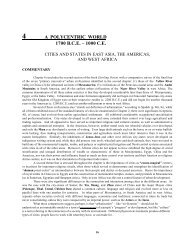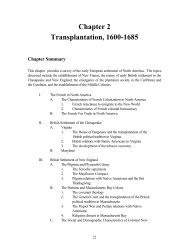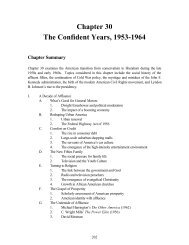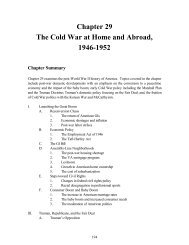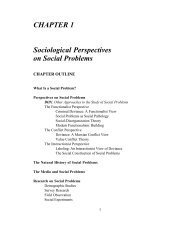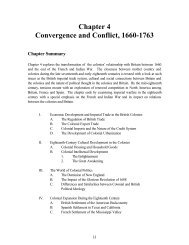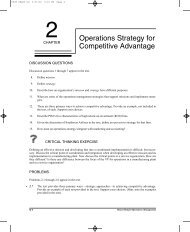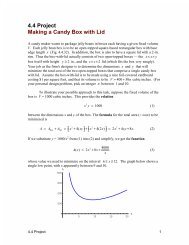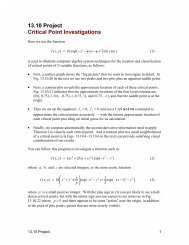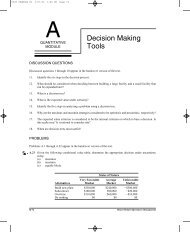Merchandising Operations and the Accounting Cycle - Pearson
Merchandising Operations and the Accounting Cycle - Pearson
Merchandising Operations and the Accounting Cycle - Pearson
Create successful ePaper yourself
Turn your PDF publications into a flip-book with our unique Google optimized e-Paper software.
debiting <strong>the</strong> Inventory account. A $500 purchase on account is recorded as follows:<br />
June 14 Inventory .......................................................................... 500<br />
Accounts payable....................................................... 500<br />
Purchased inventory on account.<br />
The Purchase Invoice: A Basic Business Document<br />
Business documents are <strong>the</strong> tangible evidence of transactions. In this section, we<br />
trace <strong>the</strong> steps that Austin Sound Centre Inc., in Kingston, Ontario, takes to order,<br />
receive, <strong>and</strong> pay for inventory. Many companies buy <strong>and</strong> sell <strong>the</strong>ir goods electronically—with<br />
no invoices, no cheques, <strong>and</strong> so on. Here we use actual documents to<br />
illustrate what takes place behind <strong>the</strong> scenes.<br />
1. Suppose Austin Sound Centre Inc. wants to stock JVC br<strong>and</strong> CD players, cassette<br />
decks, <strong>and</strong> speakers. Austin prepares a purchase order <strong>and</strong> mails it, faxes it,<br />
or transmits it via computer to JVC Canada Inc.<br />
2. On receipt of <strong>the</strong> purchase order, JVC searches its warehouse for <strong>the</strong> inventory that<br />
Austin Sound Centre Inc. ordered. JVC ships <strong>the</strong> equipment <strong>and</strong> sends <strong>the</strong> invoice<br />
to Austin Sound on <strong>the</strong> same day. The invoice is <strong>the</strong> seller’s request for payment<br />
from <strong>the</strong> purchaser. It is also called <strong>the</strong> bill.<br />
3. Often <strong>the</strong> purchaser receives <strong>the</strong> invoice before <strong>the</strong> inventory arrives. Austin<br />
Sound does not pay immediately. Instead, Austin waits until <strong>the</strong> inventory arrives<br />
in order to ensure that it is <strong>the</strong> correct type <strong>and</strong> quantity ordered, <strong>and</strong> in good<br />
condition. After <strong>the</strong> inventory is inspected <strong>and</strong> approved, Austin Sound pays<br />
JVC <strong>the</strong> invoice amount according to <strong>the</strong> terms of payment previously negotiated.<br />
Exhibit 5-3 is a copy of an invoice from JVC Canada Inc. to Austin Sound Centre Inc.<br />
From Austin Sound’s perspective, this document is a purchase invoice (it is being used<br />
to purchase goods). To JVC it is a sales invoice (it is being used to sell goods).<br />
Discounts from Purchase Prices<br />
There are two major types of discounts from purchase prices: quantity discounts<br />
<strong>and</strong> cash discounts (called purchase discounts).<br />
Quantity Discounts A quantity discount works this way. The larger <strong>the</strong> quantity<br />
purchased, <strong>the</strong> lower <strong>the</strong> price per item. For example, JVC may offer no quantity discount<br />
for <strong>the</strong> purchase of only one or two CD players, <strong>and</strong> charge <strong>the</strong> list price—<strong>the</strong><br />
full price—of $200 per unit. However, JVC may offer <strong>the</strong> following quantity discount<br />
terms in order to persuade customers to buy more CD players:<br />
Quantity<br />
Quantity Discount Net Price Per Unit<br />
Buy minimum quantity, 3 CD players 5% $190 [$200 – 0.05($200)]<br />
Buy 4–9 CD players 10% $180 [$200 – 0.10($200)]<br />
Buy more than 9 CD players 20% $160 [$200 – 0.20($200)]<br />
Suppose Austin Sound Centre Inc. five CD players from this manufacturer. The<br />
cost of each CD player is, <strong>the</strong>refore, $180. Purchase of five units on account would<br />
be recorded by debiting Inventory <strong>and</strong> crediting Accounts Payable for <strong>the</strong> total<br />
price of $900 ($180 per unit × 5 items purchased).<br />
There is no Quantity Discount account <strong>and</strong> no special accounting entry for a<br />
quantity discount. Instead, all accounting entries are based on <strong>the</strong> net price of a<br />
purchase after <strong>the</strong> quantity discount has been subtracted, as shown on <strong>the</strong> invoice.<br />
Purchase Discounts Many businesses also offer purchase discounts to <strong>the</strong>ir customers.<br />
A purchase discount is totally different from a quantity discount. A purchase<br />
discount is a reward for prompt payment. If a quantity discount is also offered, <strong>the</strong> purchase<br />
discount is computed on <strong>the</strong> net purchase amount after <strong>the</strong> quantity discount<br />
has been subtracted, fur<strong>the</strong>r reducing <strong>the</strong> cost of <strong>the</strong> inventory to <strong>the</strong> purchaser.<br />
The Inventory account should be<br />
used only for purchases of<br />
merch<strong>and</strong>ise for resale. Purchases<br />
of any o<strong>the</strong>r assets are recorded in<br />
a different asset account. For<br />
example, <strong>the</strong> purchase of supplies<br />
is debited to Supplies, not to<br />
Inventory.<br />
JVC Canada Inc.<br />
www.jvc.ca<br />
LEARNING TIP<br />
THINKING IT OVER<br />
(1) What is meant by <strong>the</strong> terms<br />
1/10 n/60?<br />
(2) By <strong>the</strong> terms 2/10 n/eom?<br />
(3) By <strong>the</strong> term n/30?<br />
A: (1) 1% discount if paid within<br />
10 days after <strong>the</strong> invoice date, or<br />
<strong>the</strong> full (“net”) amount is due in 60<br />
days.<br />
(2) 2% discount if paid within 10<br />
days, or <strong>the</strong> full amount is due at<br />
<strong>the</strong> end of <strong>the</strong> month.<br />
(3) No discount allowed,<br />
<strong>and</strong> <strong>the</strong> full amount is<br />
due in 30 days.<br />
Chapter Five <strong>Merch<strong>and</strong>ising</strong> <strong>Operations</strong> <strong>and</strong> <strong>the</strong> <strong>Accounting</strong> <strong>Cycle</strong> 227



